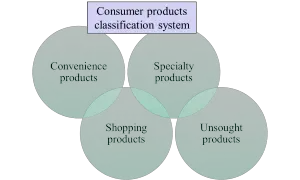The consumer products classification system is a model commonly presented in most marketing principles textbooks in the product mix chapter. This model classifies as consumer products into one of four classes, namely:
- Convenience products
- Shopping products
- Specialty products
- Unsought products
There are numerous articles discussing the consumer products classification system on this website, please refer to Related Topics at the end of this article. This article is a top level review of the important marketing mix factors for each class of product. Each product class is discussed in individual articles on this website, highlighting the role of the marketing mix for each class – again please refer to Related Topics at the end.
Contents
Key marketing mix factors when using the consumer products classification system
Convenience products
The key to success for convenience products are a strong brand (product mix) and intensive distribution (place mix). This fundamental platform can then be enhanced through in-store sales promotions (promotional and place mix) and leveraged through product line extensions (product mix).
Therefore, the key marketing mix factors for convenience products are:
- Place – intensive distribution with good in-store position
- Product – a strong recognizable brand
Shopping products
The key marketing mix elements for shopping products include selective distribution (place mix) and various trade promotions targeting the distribution channels, that is, retailers and wholesalers (which is both the promotional mix and the place mix).
Therefore, the key marketing mix factors for shopping products are:
- Place – selective distribution into the appropriate retailers
- Promotion – trade promotions targeting the channel partners
Specialty products
Specialty products rely on a high quality or a unique product that consumers will deliberately seek out (product mix). The selection of a few appropriate retailers – known as exclusive distribution (place mix) – to perform partnerships with is the other key aspects of the marketing mix.
Therefore, the key marketing mix factors for specialty products are:
- Product – high quality or unique products
- Place – exclusive distribution partnerships with appropriate retailers
Unsought products
As suggested by the name, these are products not sought out by consumers on a proactive basis. To generate sales or to penetrate the market with unsought products, usually aggressive marketing is required, often in the form of direct marketing and personal selling (promotional mix).
To support these promotional methods, often a direct channel needs to be utilized, as these products will not generate significant retailer support (place mix).
Therefore, the key marketing mix factors for unsought products are:
- Promotion – more aggressive promotional techniques
- Place – direct or shortened distribution channels
RELATED TOPICS
How products are classified in the consumer products classification system
Examples of the different classes in the consumer products classification system
Why the consumer products classification system is used
The marketing mix for convenience products
The marketing mix for shopping products
The marketing mix for specialty products
The marketing mix for unsought products
Classifying business or industrial products
External References
A link to an early Journal Article published in the Journal of Marketing
Product classification and consumer behavior Journal Article
Classifying Products Strategically

